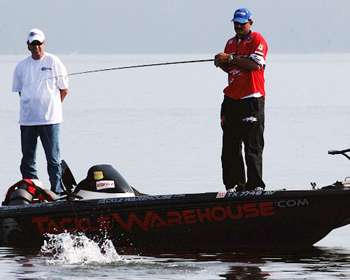
When it comes to swimbait fishing, more and more anglers are learning that the technique is both versatile and applicable in a wide variety of waters across the country. However, there are still anglers who have pigeonholed the swimbait exclusively to the prespawn and early fall.
Elite Series pro Jared Lintner says that's a mistake, as some of his best days throwing a swimbait have taken place later in the year, after water temperatures have dipped into the 50s.
"Basically, when the water temperatures start dropping, the bass go on a major feeding spree," explains the California pro. On the West Coast, the bass sense that the winter is coming, and they know that their metabolism is going to slow down. As a result, they just gorge themselves."
Lintner says bass will begin targeting bigger baits when the water temperature is hovering in the upper 50s and low 60s. It's during this window that he is likely to break out the swimbait.
When searching for bass with a swimbait, Lintner begins by concentrating his efforts in the 4- to 10-foot range. He concentrates on docks and patches of grass that are still alive.
If he is unable to find a quality shallow bite, Lintner goes deep, fishing a factory-weighted swimbait on the bottom the same way he would fish a jig. "This time of year, the bass are seeing jigs day in and day, out so the swimbait really gives those deep fish a different look," he explains. "I like to make a really long cast around a rockpile or ledge and then slowly crawl or hop the bait across the bottom."
When it comes to selecting the proper deep water swimbait for cold water, Lintner keeps his options open. East of the Mississippi, he opts for a Storm WildEye Swim Shad or a Berkley PowerBait Saltwater Mullet. "I'm not sure why, but I can't get the bass to eat those baits very well on the West Coast," he admits. "But when I'm fishing lakes like Guntersville or Kentucky Lake, the bass will jump all over them."
When he is looking for a subtle presentation, Lintner reaches for an Osprey Dink or a hand-poured deep water swimbait ranging from 3/4 to 1 1/2 ounces. "It seems like the Storm WildEye and the Berkley Mullet have a little more action than you need, especially in clear water," he opines. "There are times when that really subtle presentation just generates more bites in cold water."
Size is another important factor Linter takes into consideration when throwing a swimbait in cold water. For the majority of applications, he sticks with offerings in the 5- to 7-inch range. "That size really matches the hitch, smelt, bluegill, crappie and other baitfish this time of the year because they are typically at their biggest potential for growth," Lintner explains. "Especially if I'm fishing a like that I'm unfamiliar with, a 6-inch swimbait is hard to beat."
That being said, Lintner is quick to point out that just because a smaller size is producing, doesn't mean that bigger swimbaits should be ignored. "You want to figure out which bait will get the biggest bites. I don't want to throw a swimbait when I could be getting the same size fish on a jerkbait. The purpose of the swimbait is to target a different class of fish. If I can get bit on a 9-inch bait, then I'll throw it."
The California pro says that once the water temperature begins to approach 50 degrees, the swimbait bite quickly evaporates. "When the water gets that cold, I'll throw a jig to catch the bigger bass because they just don't want to move very far to eat a bait," he explains.




